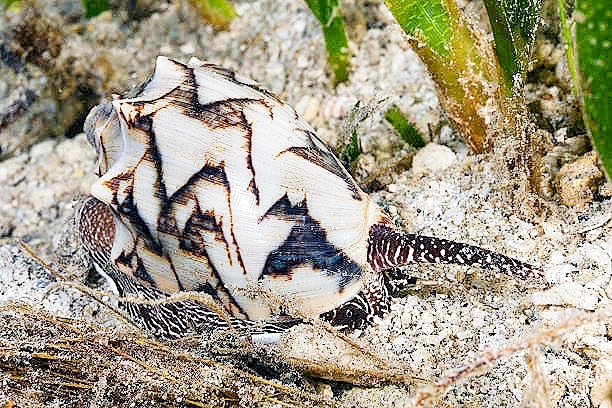Perhaps the most widely-recognized volutid of all, the bat volute is an abundant species widely distributed in the western Pacific where it ranges from Taiwan to the Philippines to Indonesia to northern Australia. A carnivorous and predatory snail feeding mostly on other molluscs, it dwells in shallow sandy bottoms from low intertidal zone down to about 30 m deep, often in seagrass beds. It is an extremely variable species in terms of shell morphology, colouration, and pattern. The shell can be narrow and almost entirely lacking in shoulder spines or very wide with thick, well-developed shoulder spines; pure white to red to dark brown; and from carrying numerous lightning-like axial zigzags forming tent-like patterns combined with wide colour bands, to lacking patterns entirely. The heavily ribbed, bulbous protoconch always remains consistent, however, and provides a reliable way to distinguish this species from other species in the genus Cymbiola. The foot is dark brown in colouration and usually carry numerous yellow dots or streaks that vary greatly among individuals. The head and cephalic tentacles have the same colour sheme but is often more heavily patterned than the foot. Typical shell length around 80 mm, extremely large specimens may exceed even 160 mm. Recently, a population with reddish shells typically displaying particularly attractive fine tent-like patterns and dark bands was found around Banggai Islands in Central Sulawesi, Indonesia (shown) and given the subspecies name Cymbiola vespertilio peterstimpsoni Cossignani & Allary, 2022. Considering the extreme variation displayed by this species, however, even this population falls within the known variability and this subspecies name is unlikely to represent an evolutionary lineage truly divergent from the nominal subspecies, instead it is mostly likely a regional form. In fact, specimens from this locality themselves exhibit a high level of variation that intergrades with specimens known from other parts of Indonesia as well as the Philippines. Future research, particularly using molecular methods, will be helpful in shedding light to the true relationship between this and other populations of the species. |

